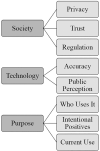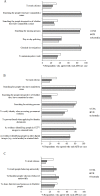Public attitudes towards the use of automatic facial recognition technology in criminal justice systems around the world
- PMID: 34644306
- PMCID: PMC8513835
- DOI: 10.1371/journal.pone.0258241
Public attitudes towards the use of automatic facial recognition technology in criminal justice systems around the world
Abstract
Automatic facial recognition technology (AFR) is increasingly used in criminal justice systems around the world, yet to date there has not been an international survey of public attitudes toward its use. In Study 1, we ran focus groups in the UK, Australia and China (countries at different stages of adopting AFR) and in Study 2 we collected data from over 3,000 participants in the UK, Australia and the USA using a questionnaire investigating attitudes towards AFR use in criminal justice systems. Our results showed that although overall participants were aligned in their attitudes and reasoning behind them, there were some key differences across countries. People in the USA were more accepting of tracking citizens, more accepting of private companies' use of AFR, and less trusting of the police using AFR than people in the UK and Australia. Our results showed that support for the use of AFR depends greatly on what the technology is used for and who it is used by. We recommend vendors and users do more to explain AFR use, including details around accuracy and data protection. We also recommend that governments should set legal boundaries around the use of AFR in investigative and criminal justice settings.
Conflict of interest statement
The authors have declared that no competing interests exist.
Figures














References
-
- The Biometrics Institute. Understanding biometrics. 2018 Sept 18 [Cited 2021 May 25]. Available from: https://www.biometricsinstitute.org/wp-content/uploads/Understanding-Bio....
-
- Mann M, Smith M. Automated facial recognition technology: Recent developments and approaches to oversight. UNSWLJ. 2017;40:121.
-
- Centre for Data Ethics and Innovation. Snapshot series: Facial recognition technology. 2020 May [Cited 2021 May 25]. Available from: https://assets.publishing.service.gov.uk/government/uploads/system/uploa....
-
- White D, Towler A, Jeffery L, Kemp R, Palermo R, Ballantyne K et al.. Evaluating face identification expertise: Turning theory into best practice. 2020. August [Cited 2021 May 25]. Available from: https://socialsciences.org.au/workshop/evaluating-face-identification-ex....
Publication types
MeSH terms
LinkOut - more resources
Full Text Sources
Miscellaneous

